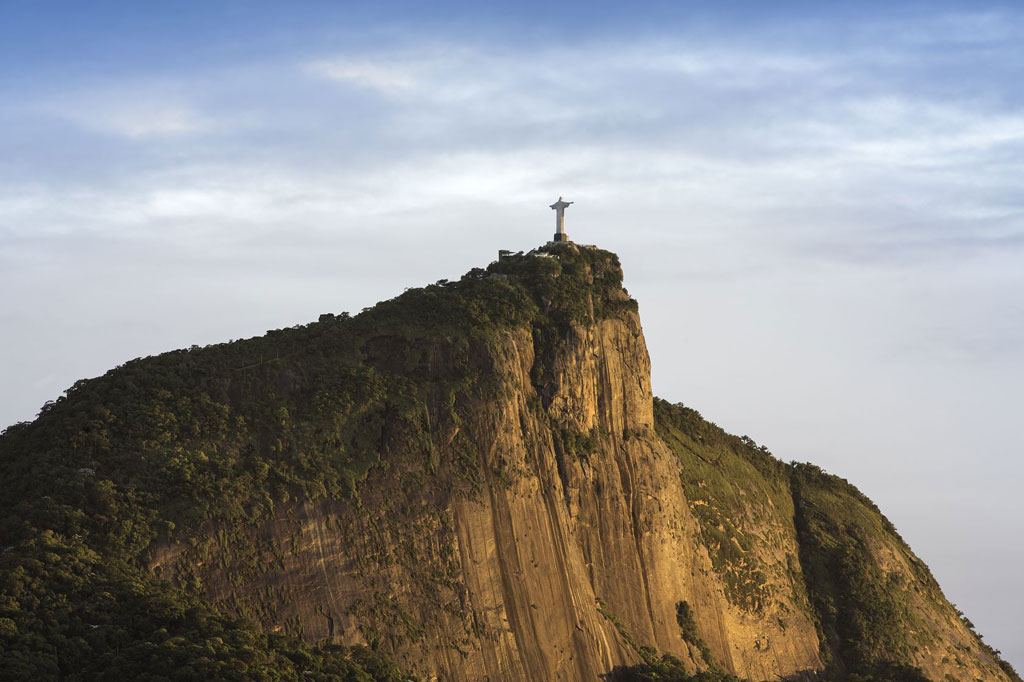
Christ the Redeemer atop Rio’s Corcovado. Photo © marchello74/123rf.
Late last week, Brazilians sobbed and beat their breasts as they mourned the tragic and unexpected elimination of the Seleção at the World Cup in South Africa. Bars continued to do booming business, but table talk revolved around post-game analyses that minutely dissected every wrong move that led to the Brazilians’ loss to the Dutch. Amid the atmosphere of a collective hangover that reigned throughout the country, there was, however, one bright spot: the re-opening of visits to Rio’s Corcovado.Back in April, torrential rains, accompanied by floods and mudslides, had wreaked havoc on Rio de Janeiro. As I reported in an earlier blog post, one of the casualties of the meteorological mayhem was the city’s most iconic landmark, the Cristo Redentor (Christ the Redeemer) statue.
The Cristo Redentor is a benevolent and secularly sacred presence that can be glimpsed throughout the city, no matter where you are. Hovering atop Corcovado mountain, its arms open in the most welcoming of embraces, the Cristo Redentor is a benevolent and secularly sacred presence that can be glimpsed throughout the city, no matter where you are. In the years since it was first unveiled in 1931, it has become Rio’s top tourist attraction, luring over 2 million visitors a year. More importantly, it has become a symbol of Rio itself.Accordingly, Cariocas reacted strongly when their beloved icon was not only damaged by record rainfall, but defiled, shortly afterward, by vandals who sprayed graffiti all over the statue’s head and arms. Rio’s mayor Eduardo Paes referred to the sacrilegious attack as a “crime against the nation” and offered a reward of R$10,000 (roughly $5,000) for information that would help track down the perpetrators (who were subsequently apprehended).
Prior to the events of April, there had already been plans to restore the world’s largest Art Deco statue, which will be celebrating its 80th birthday in 2011. A budget of over R$7 million (almost $4 million) had been set aside for activities that included repairing cracks in the Cristo’s forehead caused by lightning, scraping away fungi that had invaded the Cristo’s chin, and removing tiny plants that had sprouted up amid the Cristo’s toes.
The original restoration project was to have been carried out without closing the landmark to visitors. However, once the rains forced the closing of the entire site, restorers took advantage of the situation to perform a major overhaul that involved over 100 workers climbing up and down scaffolding that covered the entire statue. When it was discovered that rain had seeped into the Cristo’s outstretched arms, 300 liters of water were drained from each limb and 300 bags of cement were required to patch them up.
While the statue itself is fashioned out of reinforced concrete, the exterior is covered with tiny mosaic tiles (see photos) made of soapstone that hail from the state of Minas Gerais. Luckily, the Archdiocese has a reserve from the original quarry stockpiled in Rio; 60,000 tiles were needed to replace cracked or broken ones. In order to keep the Cristo safe during electrical storms, new lightning rods were implanted in the statue’s head and arms.
Although the unveiling of the statue, and the reopening of Corcovado to visitors on June 30, was a joyous event, the raison d’etre behind the new lighting scheme – green and yellow floodlights meant to send a special signal of support to the Brazilian Seleção – was short lived seeing as on July 2, Brazilian’s hopes of becoming World Cup hexachampions were dashed.
While they wait for the next World Cup to roll around in four years, Brazilians can perhaps find some solace in the words of the immortal Carioca bard, Antônio Carlos (Tom) Jobim, whose bossa nova classic, Corcovado (featured in the clip above), speaks of having:
Lots of calm to think
And time to dream
From the window one can see Corcovado
The Redeemer, how beautiful